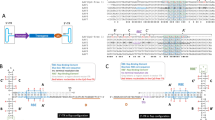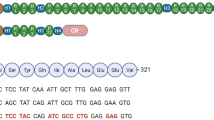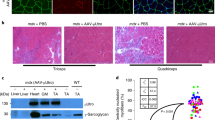Abstract
The limb girdle muscular dystrophies (LGMD) are a genetically and phenotypically heterogeneous group of degenerative neuromuscular diseases. A subset of the genetically recessive forms of LGMD are caused by mutations in the four muscle sarcoglycan genes (α, β, γ and δ). The coding sequences of all known sarcoglycan genes are smaller than 2 kb, and thus can be readily packaged in recombinant adeno-associated virus (rAAV) vectors. Previously, we have demonstrated highly efficient and sustained transduction in mature muscle tissue of immunocompetent animals with rAAV vectors. In this report, we utilize recombinant AAV containing the δ-sarcoglycan gene for genetic complementation of muscle diseases using a δ- sarcoglycan-deficient hamster model (Bio14.6). We show efficient delivery and widespread expression of δ-sarcoglycan after a single intramuscular injection. Importantly, rAAV vector containing the human δ-sarcoglycan cDNA restored secondary biochemical deficiencies, with correct localization of other sarcoglycan proteins to the muscle fiber membrane. Interestingly, restoration of α-, as well as β-sarcoglycan was homogeneous and properly localized throughout transduced muscle, and appeared unaffected by dramatic overexpression of δ-sarcoglycan in the cytoplasm of some myofibers. These results support the feasibility of rAAV vector’s application to treat LGMD by means of direct in vivo gene transfer.
This is a preview of subscription content, access via your institution
Access options
Subscribe to this journal
Receive 12 print issues and online access
$259.00 per year
only $21.58 per issue
Buy this article
- Purchase on Springer Link
- Instant access to full article PDF
Prices may be subject to local taxes which are calculated during checkout




Similar content being viewed by others
References
Berns KI, Linden RM . The cryptic life style of adeno-associated virus Bioessays 1995 17: 237–245
Berns KI . Parvoviridae: the viruses and their replication. In: Fields, Knipe DM, Howley PM (eds). Virology Lippincott-Raven: Philadelphia 1996 2173–2198
Feero WG et al. Viral gene delivery to skeletal muscle: insights on maturation-dependent loss of fiber infectivity for adenovirus and herpes simplex type 1 viral vectors Hum Gene Ther 1997 8: 371–380
Huard J et al. The basal lamina is a physical barrier to herpes simplex virus-mediated gene delivery to mature muscle fibers J Virol 1996 70: 8117–8123
Xiao X, Li J, Samulski RJ . Efficient long-term gene transfer into muscle tissue of immunocompetent mice by adeno-associated virus vector J Virol 1996 70: 8098–8108
Clark KR, Sferra TJ, Johnson PR . Recombinant adeno-associated viral vectors mediate long-term transgene expression in muscle Hum Gene Ther 1997 8: 659–669
Fisher KJ et al. Recombinant adeno-associated virus for muscle directed gene therapy Nature Med 1997 3: 306–312
Kessler PD et al. Gene delivery to skeletal muscle results in sustained expression and systemic delivery of a therapeutic protein Proc Nat Acad Sci USA 1996 93: 14082–14087
Herzog RW et al. Stable gene transfer and expression of human blood coagulation factor IX after intramuscular injection of recombinant adeno-associated virus Proc Nat Acad Sci USA 1997 94: 5804–5809
Monahan PE et al. Direct intramuscular injection with recombinant AAV vectors results in sustained expression in a dog model of hemophilia Gene Therapy 1998 5: 40–49
Murphy JE et al. Long-term correction of obesity and diabetes in genetically obese mice by a single intramuscular injection of recombinant adeno-associated virus encoding mouse leptin Proc Nat Acad Sci USA 1997 94: 13921–13926
Zhou S et al. Adeno-associated virus-mediated delivery of erythropoietin leads to sustained elevation of hematocrit in nonhuman primates Gene Therapy 1998 5: 665–670
Ozawa E et al. From dystrophinopathy to sarcoglycanopathy: evolution of a concept of muscular dystrophy Musc Nerve 1998 21: 421–438
Bonnemann CG, McNally EM, Kunkel LM . Beyond dystrophin: current progress in the muscular dystrophies (published erratum appears in Curr Opin Pediatr 1997; 9: 196) Curr Opin Pediatr 1996 8: 569–582
Hoffman EP, Clemens PR . HyperCKemic, proximal muscular dystrophies and the dystrophin membrane cytoskeleton, including dystrophinopathies, sarcoglycanopathies, and merosinopathies Curr Opin Rheumatol 1996 8: 528–538
Duggan DJ et al. Mutations in the delta-sarcoglycan gene are a rare cause of autosomal recessive limb-girdle muscular dystrophy (LGMD2) Neurogenetics 1996 1: 49–58
Duggan DJ et al. Mutations in the sarcoglycan genes in patients with myopathy (see comments) New Engl J Med 1997 336: 618–624
Bonnemann CG et al. Beta-sarcoglycan (A3b) mutations cause autosomal recessive muscular dystrophy with loss of the sarcoglycan complex (published erratum appears in Nat Genet 1996; 12: 110) Nat Genet 1995 11: 266–273
Bonnemann CG et al. Genomic screening for beta-sarcoglycan gene mutations: missense mutations may cause severe limb-girdle muscular dystrophy type 2E (LGMD 2E) Hum Mol Genet 1996 5: 1953–1961
Duggan DJ, Hoffman EP . Autosomal recessive muscular dystrophy and mutations of the sarcoglycan complex Neuromus Disorders 1996 6: 475–482
Nigro V et al. Autosomal recessive limb-girdle muscular dystrophy, LGMD2F, is caused by a mutation in the delta-sarcoglycan gene Nat Genet 1996 14: 195–198
Lim LE et al. Beta-sarcoglycan: characterization and role in limb-girdle muscular dystrophy linked to 4q12 Nat Genet 1995 11: 257–265
Jung D et al. Characterization of delta-sarcoglycan, a novel component of the oligomeric sarcoglycan complex involved in limb-girdle muscular dystrophy J Biol Chem 1996 271: 32321–32329
Dincer P et al. A biochemical, genetic, and clinical survey of autosomal recessive limb girdle muscular dystrophies in Turkey Ann Neurol 1997 42: 222–229
Fanin M et al. Genetic epidemiology of muscular dystrophies resulting from sarcoglycan gene mutations J Med Genet 1997 34: 973–977
Mizuno Y et al. Selective defect of sarcoglycan complex in severe childhood autosomal recessive muscular dystrophy muscle Biochem Biophys Res Commun 1994 203: 979–983
Noguchi S et al. Mutations in the dystrophin-associated protein gamma-sarcoglycan in chromosome 13 muscular dystrophy (see comments) Science 1995 270: 819–822
Matsumura K et al. Deficiency of the 50K dystrophin-associated glycoprotein in severe childhood autosomal recessive muscular dystrophy Nature 1992 359: 320–322
Mizuno Y et al. Sarcoglycan complex is selectively lost in dystrophic hamster muscle Am J Pathol 1995 146: 530–536
Nigro V et al. Identification of the Syrian hamster cardiomyopathy gene Hum Mol Genet 1997 8: 601–607
Sakamoto A et al. Both hypertrophic and dilated cardiomyopathies are caused by mutation of the same gene, delta-sarcoglycan, in hamster: an animal model of disrupted dystrophin-associated glycoprotein complex Proc Natl Acad Sci USA 1997 94: 13873–13878
Carrie A et al. Mutational diversity and hot spots in the alpha-sarcoglycan gene in autosomal recessive muscular dystrophy (LGMD2D) J Med Genet 1997 34: 470–475
Chamberlain JS et al. Interactions between dystrophin and the sarcolemma membrane Soc Gen Physiol Series 1997 52: 19–29
Ettinger AJ, Feng G, Sanes JR . Epsilon-Sarcoglycan, a broadly expressed homologue of the gene mutated in limb-girdle muscular dystrophy 2D J Biol Chem 1997 272: 32534–32538
McNally EM, Ly CT, Kunkel LM . Human epsilon-sarcoglycan is highly related to alpha-sarcoglycan (adhalin), the limb girdle muscular dystrophy 2D gene FEBS Lett 1998 422: 27–32
Homburger F et al. Primary, generalized polymyopathy and cardiac necrosis in an inbred line of Syrian hamsters Med Exp 1962 6: 339–345
Snyder R et al. Efficient and stable AAV-mediated transduction in the skeletal muscle of adult immuncompetent mice Hum Gene Ther 1997 8: 1891–1900
Jooss K et al. Transduction of dendritic cells by DNA viral vectors directs the immune response to transgene products in muscle fibers J Virol 1998 72: 4212–4223
Kaczmarek L et al. Induction of cellular DNA synthesis by purified adenovirus E1A proteins Virology 1986 152: 1–10
Kaplitt MG et al. Long-term gene expression and phenotypic correction using adeno-associated virus vectors in the mammalian brain Nat Genet 1994 8: 148–154
Kaplitt MG et al. Long-term gene transfer in porcine myocardium after coronary infusion of an adeno-associated virus vector Ann Thor Surg 1996 62: 1669–1676
Xiao X, Li J, Samulski RJ . Production of high-titer recombinant adeno-associated virus vectors in the absence of helper adenovirus J Virol 1998 72: 2224–2232
Holt KH et al. Functional rescue of the sarcoglycan complex in the BIO 14.6 hamster using delta-sarcoglycan gene transfer Mol Cell 1998 1: 841–848
Hoffman EP, Brown Jr RH, Kunkel LM . Dystrophin: the protein product of the Duchenne muscular dystrophy locus Cell 1987 51: 919–928
Koenig M, et al . Complete cloning of the Duchenne muscular dystrophy (DMD) cDNA and preliminary genomic organization of the DMD gene in normal and affected individuals Cell 1987 50: 509–517
Wu P et al. Adeno-associated virus vector-mediated transgene integration into neurons and other nondividing cell targets J Virol 1998 72: 5919–5926
Jaynes JB et al. The muscle creatine kinase gene is regulated by multiple upstream elements, including a muscle-specific enhancer Mol Cell Biol 1988 8: 62–70
Zolotukhin S et al. A ‘humanized’ green fluorescent protein cDNA adapted for high-level expression in mammalian cells J Virol 1996 70: 4646–4654
Snyder R, Xiao X, Samulski RJ . Production of recombinant adeno-associated viral vectors. In: N. Dracopoli et al. (eds). Current Protocols in Human Genetics John Wiley & Sons: New York 1995 12.1.1–12.2.23
Li J, Samulski RJ, Xiao X . Role for highly regulated rep gene expression in adeno-associated virus vector production J Virol 1997 71: 5236–5243
Author information
Authors and Affiliations
Rights and permissions
About this article
Cite this article
Li, J., Dressman, D., Tsao, Y. et al. rAAV vector-mediated sarcogylcan gene transfer in a hamster model for limb girdle muscular dystrophy. Gene Ther 6, 74–82 (1999). https://doi.org/10.1038/sj.gt.3300830
Received:
Accepted:
Published:
Issue Date:
DOI: https://doi.org/10.1038/sj.gt.3300830
Keywords
This article is cited by
-
The ties that bind: functional clusters in limb-girdle muscular dystrophy
Skeletal Muscle (2020)
-
Muscle and Heart Function Restoration in a Limb Girdle Muscular Dystrophy 2I (LGMD2I) Mouse Model by Systemic FKRP Gene Delivery
Molecular Therapy (2014)
-
δ-Sarcoglycan-deficient muscular dystrophy: from discovery to therapeutic approaches
Skeletal Muscle (2011)
-
RNA Interference Improves Myopathic Phenotypes in Mice Over-expressing FSHD Region Gene 1 (FRG1)
Molecular Therapy (2011)
-
Animal Models for Target Diseases in Gene Therapy — using DNA and siRNA Delivery Strategies
Pharmaceutical Research (2009)



